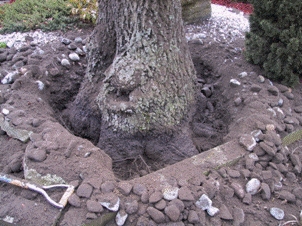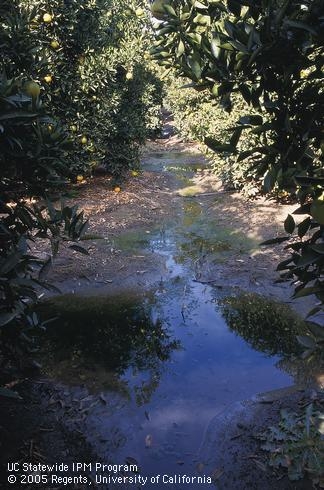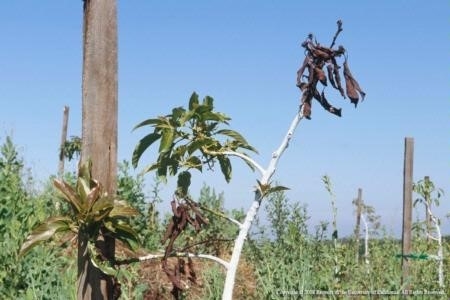
Posts Tagged: asphyxiation
Wet Roots
I recently harvested 'GEM' avocados and found that some of the fruit was splitting. The split fruit was just turning from a bright green to one with dark tinges. There were also gobs of snails and slugs on the fruit. I mentioned the cracking fruit to a grower who had been harvesting ‘Hass' fruit and the comment was that their fruit was turning black on the tree and falling. This is way early for ‘Hass' to show this level of maturity.
Several mandarin growers also mention peel breakdown or rind disorder. There can be brown, water-soaked blotches or dark, sunken areas developing on the rind after rainy weather. The fruit matures rapidly, turning orange early. Secondary fungi can then colonize the affected areas. It's more of a problem in northern California where thin-skinned satsumas are grown and there are early rains. But accelerated maturity and fruit/whole plant breakdown can happen on all citrus and many other fruiting plant species.
This is another example of accelerated maturity due to wet roots. The roots need air, like we do, and when they are asphyxiated for even short periods of time, they start signaling the rest of the plant that something is wrong. Prolonged rainy periods or actual ponding conditions will lead to ethylene precursors that start the maturation process – “banana in a bag” effect. This is in spite of many crops being delayed in their maturity because of the cold winter we have had. Drown the roots, and they start responding as if they are choking. They are. In some cases, leaves will droop (epinasty or wilting) and drop, immediately. And then the fruit may drop right away or then just start rapidly maturing/ripening on the tree. Once this process starts, there's no stopping it. Some growers, seeing fruit drop have gone out to start harvests, but then inadvertently gotten their forklifts stuck in the mud. Rain can have its downsides.

mandarin rind disorder

lemon cold wet exposure
Too Much Rain?
What Can Happen With Too Much Rain?
Rain is wonderful stuff. If it comes and washes the accumulated salts of the last several years out of the root zones of citrus and avocado, that's a good thing. But what happens if there is a little too much of the good stuff? In the winter of 2005, Venture got over 40” of rain, which is 200% of what is normal. The last time big rains occurred prior to that was in the winter of 1997-98. That year the rains were evenly spaced on almost a weekly basis through the winter and into the late spring and over 50" fell. That year we had major problems with both citrus and avocados collapsing from asphyxiation. The same occurred in 2005, but not so pronounced.
This April we have had a lot more rain than we normally see and in some young trees with poorly developed root systems, we have seen some collapse from asphyxiation. Avocados tend to be more susceptible than citrus, and some rootstocks more than others.
Asphyxiation is a physiological problem that may affect certain branches, whole limbs or the entire tree. Leaves wilt and may fall, the fruit withers and drops and the branches die back to a greater or lesser extent. The condition develops so rapidly that it may be regarded as a form of collapse. Usually, the larger stems and branches remain alive, and after a time, vigorous new growth is put out so that the tree tends to recover. Young trees can be harder hit, but sunburn damage from lack of leaves may be more of a problem.
Asphyxiation is related to the air and water conditions of the soil. The trouble appears mainly in fine-textured or shallow soils with impervious sub-soils. In 1997-98, this even occurred on slopes with normally good drainage because the rains were so frequent. When such soils are over-irrigated or wetted by rains, the water displaces the soil oxygen. The smaller roots die when deprived of oxygen. When the stress of water shortage develops, the impaired roots are unable to supply water to the leaves rapidly enough and the tree collapses. The condition is accentuated when rainy weather is followed by winds or warm conditions. These are exactly the conditions we saw in the last weeks of April and beginning of May - wet weather and then 90 degree heat. Boom. hence some of the problems in young orchards on heavier soils.
It doesn't take standing water to have asphyxiation occur.
Canopy treatment in less severe instances of asphyxiation consists of cutting back the dead branches to live wood. If leaf drop has been excessive, the tree should be whitewashed to prevent sunburn. Fruit, if mature should be harvested as soon as possible to prevent loss. In the case of young trees, less than two years of age, recovery sometimes does not occur, and replanting should be considered if vigorous regrowth does not occur by July. As soon as defoliation is evident, whitewashing should be done to protect them to give them a chance for recovery.
Asphyxiation can be reduced by proper planting and grading. If an impervious layer is identified, it should be ripped prior to planting. The field should be graded so that water has somewhere to run off the field during high rainfall years. Heavier soils might require planting on berms or mounds so that the crown roots have a better chance of being aerated.
Hindsight is always great. Post-plant, if an impervious layer can be identified and is shallow enough to break through, ripping alongside the tree or drilling 4-6 inch post holes at the corners of the tree canopy can improve drainage. It is important that the ripper blade or auger gets below the impervious layer for this technique to be effective. If there is a thick layer of mulch reducing soil evaporation, pulling it back to allow the sun to help dry it out faster will help. It's not a lot of work with small trees, but big time work if it's big trees with thick mulch.
Asphyxiated tree that has been whitewashed
After Flooding, Buried Trunks a Problem
A trunk "below grade", that is a buried trunk, is a problem for most trees. Willows and other riparian trees along water ways that are inundated regularly can adapt to a change in soil depth around their trunks. That's not true of most of our commercial tree species, and avocados and citrus are really susceptible to buried trunks/stems. they asphyxiate. This can be a very common problem at planting when a hole is too deep and the new tree settles in the loosen earth and gradually the stem is buried. Or, when the grower is doing the "right thing" and using an organic planting mix that gradually decomposes and the tree settles into the ground and the crown is covered by dirt. The tree then starts looking bad - leaves yellow. The canopy defoliates. All the while, the grower is putting on more water and more fertilizer and the tree looks worse and worse. Remove the soil from around the base, and voila, in a few months the tree is happy again. If the dirt isn't moved, the stressed tree is now susceptible to root rots, both Phytophthora and Armillaria. Those problems are a lot worse than just lack of air.
This suffocation is a common problem after flooding. Dirt from higher up moves into lower positions, gravity moving dirt can move a lot. It accumulates around the base of the tree. The grower is preoccupied with other things that occur with flooding and does nothing. A few months later, the trees start turning yellow especially when the weather warms up and they are more active and more water is being applied. Flooding can also spread disease organism from other areas that are contaminated. Oak root fungus is frequently spread in flooding waters, especially in the lower positions in little valleys.
Pulling that accumulated soil away from tree is important for tree health. It's something that needs to be done soon after the flooding incident, or any event that buries the tree trunk.

buried tree trunk
Asphyxiation???
Oh, oh is there going to be a wet fall and winter? If it comes and washes the accumulated salts of the last four years out of the root zones of citrus and avocado, that's a good thing. But what happens if there is a little too much of the good stuff? In the winter of 2005, Venture got over 40” of rain, which is 200% of what is normal. The last time big rains occurred prior to that was in the winter of 1997-98. That year the rains were evenly spaced on almost a weekly basis through the winter and into the late spring and over 50" fell. That year we had major problems with both citrus and avocados collapsing from asphyxiation. The same occurred in 2005, but not so pronounced. This winter could also see some collapse.
Asphyxiation is a physiological problem that may affect certain branches, whole limbs or the entire tree. Leaves wilt and may fall, the fruit withers and drops and the branches die back to a greater or lesser extent. The condition develops so rapidly that it may be regarded as a form of collapse. Usually, the larger stems and branches remain alive, and after a time, vigorous new growth is put out so that the tree tends to recover.
Asphyxiation is related to the air and water conditions of the soil. The trouble appears mainly in fine-textured or shallow soils with impervious sub-soils. In 1997-98, this even occurred on slopes with normally good drainage because the rains were so frequent. When such soils are over-irrigated or wetted by rains, the water displaces the soil oxygen. The smaller roots die when deprived of oxygen. When the stress of water shortage develops, the impaired roots are unable to supply water to the leaves rapidly enough and the tree collapses. The condition is accentuated when rainy weather is followed by winds or warm conditions.
Canopy treatment in less severe instances consists of cutting back the dead branches to live wood. If leaf drop has been excessive, the tree should be whitewashed to prevent sunburn. Fruit, if mature should be harvested as soon as possible to prevent loss. In the case of young trees, less than two years of age, recovery sometimes does not occur, and replanting should be considered if vigorous regrowth does not occur by July.
Asphyxiation can be reduced by proper planting and grading. If an impervious layer is identified, it should be ripped prior to planting. The field should be graded so that water has somewhere to run off the field during high rainfall years. Heavier soils might require planting on berms or mounds so that the crown roots have a better chance of being aerated.
Post-plant, if an impervious layer can be identified and is shallow enough to break through, ripping alongside the tree or drilling 4-6 inch post holes at the corners of the tree can improve drainage. It is important that the ripper blade or auger gets below the impervious layer for this technique to be effective.
We don't know what the future holds. Hopefully rain that does some good without too much harm.
Avocado asphyxiation 2005

asphyxiation avocado
Asphyxiation
Standing water can lead to asphyxiation
ASPHYXIATION
Asphyxiation is a physiological problem that may affect certain branches, whole limbs or the entire tree. Leaves wilt and may fall, the fruit withers and drops and the branches die back to a greater or lesser extent. The condition develops so rapidly that it may be regarded as a form of collapse. Usually, the larger stems and branches remain alive, and after a time, vigorous new growth is put out so that the tree tends to recover.
Asphyxiation is related to the air and water conditions of the soil. The trouble appears mainly in fine-textured or shallow soils with impervious sub-soils. In 1997-98, this even occurred on slopes with normally good drainage because the rains were so frequent. When such soils are over-irrigated or wetted by rains, the water displaces the soil oxygen. The smaller roots die when deprived of oxygen. When the stress of water shortage develops, the impaired roots are unable to supply water to the leaves rapidly enough and the tree collapses. The condition is accentuated when rainy weather is followed by winds or warm conditions.
Canopy treatment in less severe instances consists of cutting back the dead branches to live wood. If leaf drop has been excessive, the tree should be whitewashed to prevent sunburn. Fruit, if mature should be harvested as soon as possible to prevent loss. In the case of young trees, less than two years of age, recovery sometimes does not occur, and replanting should be considered if vigorous regrowth does not occur by July.
Asphyxiation can be reduced by proper planting and grading. If an impervious layer is identified, it should be ripped prior to planting. The field should be graded so that water has somewhere to run off the field during high rainfall years. Heavier soils might require planting on berms or mounds so that the crown roots have a better chance of being aerated.
Post-plant, if an impervious layer can be identified and is shallow enough to break through, ripping along side the tree of drilling 4-6 inch post holes at the corners of the tree can improve drainage. It is important that the ripper blade or auger gets below the impervious layer for this technique to be effective.



